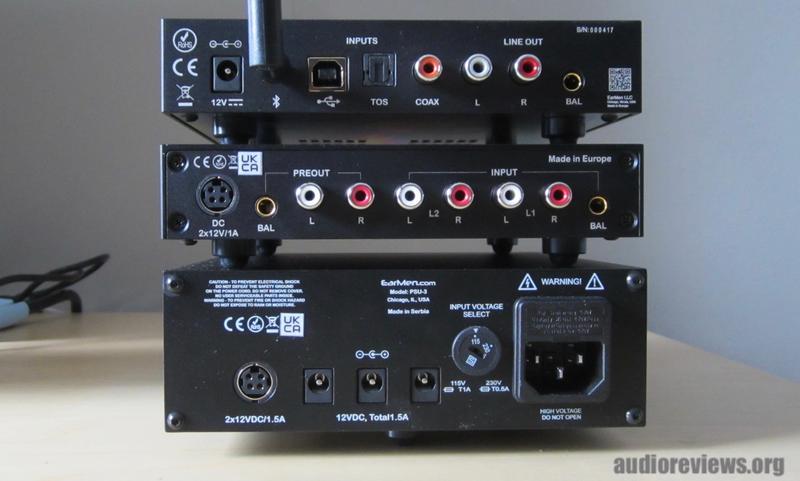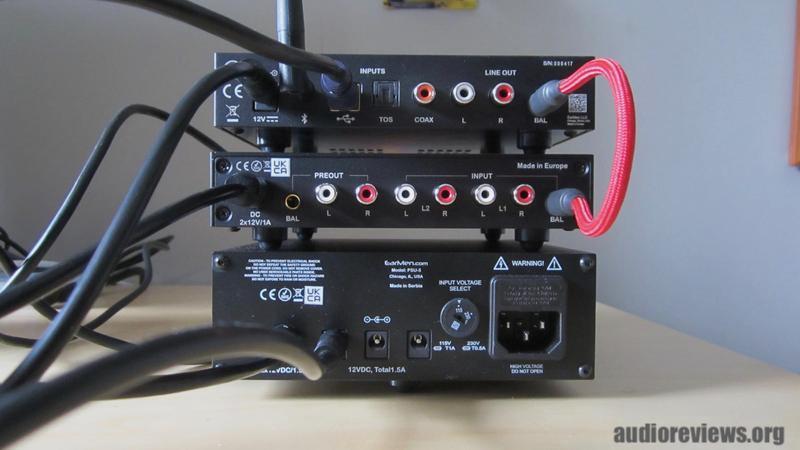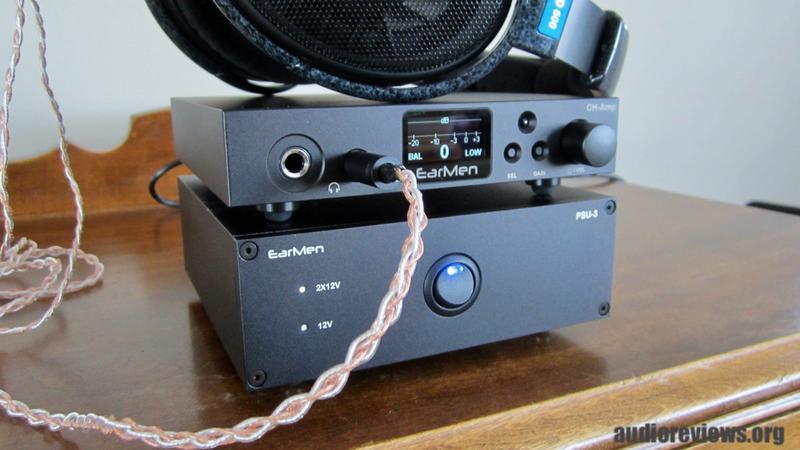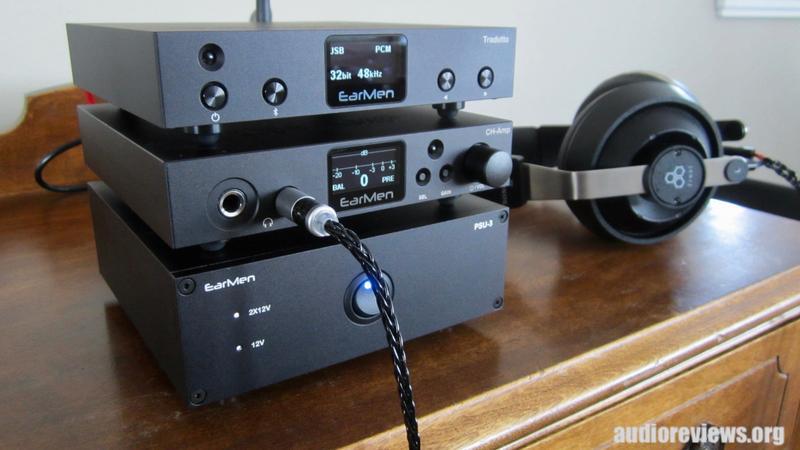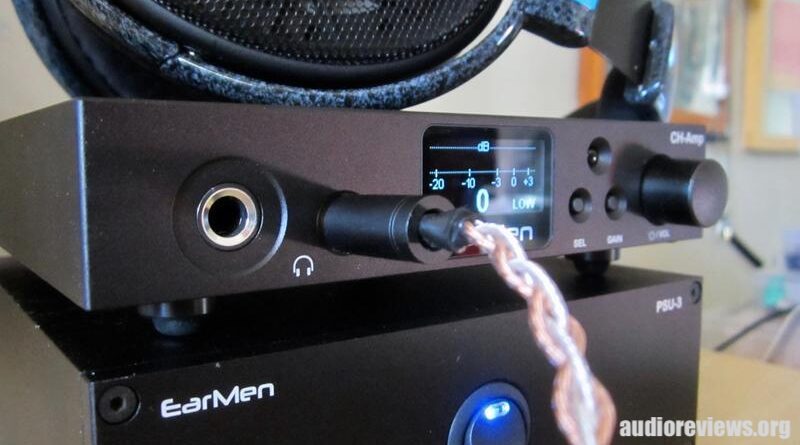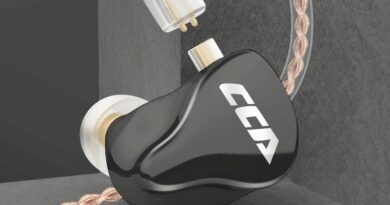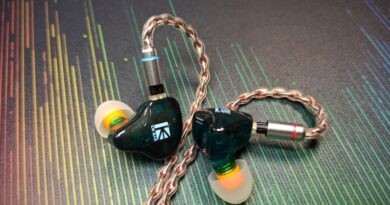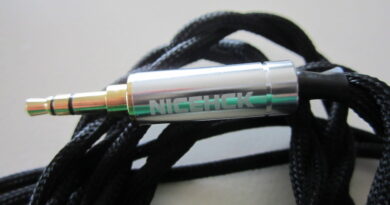EarMen CH-Amp Review – Complete Control
The EarMen CH-Amp is a fantastic headphone amplifier that marries perfect build and haptic with minimalistic design, pragmatism, and great sound. Half of the package is a 12 V linear power supply that can supply four devices simultaneously. Paired with the EarMen Tradutto DAC, the system can be endgame for audio enthusiasts on an “upper medium” budget.
PROS
- Superb sound with the balanced circuit
- Great synergy with EarMen Tradutto DAC (balanced)
- EXCEPTIONAL premium build
- EXCEPTIONAL linear power supply with three additional sockets for three more 12 V devices
- …upgrades the Tradutto DAC ‘s sound
- Small footprint on desk
CONS
- Optically & functionally somewhat married to Tradutto
- Finicky safety mechanism
- Remote does not control gain
In this Article
The EarMen CH-Amp was supplied by the company and I thank them for that – and for their patience (I tested critically for over 2 months). You can purchase it for $1480 (at the time of writing) from the EarMen shop.
Introduction
EarMen are designers and manufacturers of premium audio products from Europe. They are registered in Chicago however develop and produce in Serbia. They are a young company, but with lots of experience as they are an offshoot of premium manufacturer Auris Audio.
EarMen are confident. They do not offer umpteen models of the same at similar prices. No, one model fits all. And they don’t hand the responsibility of a good sound to the user through countless tweaking options. Their devices sound as good as they should out of the box.
EarMen products have long shelf lives: they are well designed so that the buyer does not have to fear their purchase will be superseded by an “upgrade” anytime soon.
EarMen like puns in their product names: Donald DAC, ST-Amp, and TR-Amp. And now the CH-Amp.
EarMen impressed us first with their dongles, the $129 Eagle and the $199 Sparrow. The former is still the lowest-priced dongle with premium sound on the market in my opinion. And the Sparrow is Biodegraded’s daily driver. It is not only the sound that is impressive but also the design and premium build.
Next, EarMen delighted us with their portable headphone amps, the affordable TR-Amp and the pricier Angel. And then came the Tradutto, their premium DAC designed to go with the CH-Amp. And, boy, does this synergy work.
Specifications CH-Amp
| Highlights | |
|---|---|
| Circuits | single ended (6.35 mm), balanced (4.4 mm) |
| Output Impedance (headphones) | <1 Ω (single ended and balanced) |
| Output Impedance (Line Out) | 100 Ω (single ended), 200 Ω (balanced) |
| Max. Power | 3.8 W (balanced), 1.5 W (single ended) @ 32 Ω |
| SNR | 116-119 dB (depending on circuit and low/high gain) |
| Tested at | $1480 |
| User Manual | Google Drive |
| Product Link | https://earmen-shop.com/products/earmen-ch-amp |
Inputs
| Line 1 | RCA Single End Input | Input Sensitivity = 2V |
| Line 2 | RCA Single End Input | Input Sensitivity = 2V |
| Line 3 | Balanced 4.4 mm | Input Sensitivity = 4V |
Headphone Outputs
| SE 6.35mm | output impedance = <1 Ω |
| Balanced 4.4mm | output impedance = <1 Ω |
Pre Outputs
| RCA (SE output) | output impedance = 100Ω |
| Balanced 4.4mm | output impedance = 200Ω |
Single-ended output
| SE Input | BAL Input | |
| Output Level | 7Vrms | 11Vrms |
| Max Power | 1,5 W | 3,8 W |
| THD+N | 0.0008% | 0.0005% |
| SNR | >116dB | >118dB |
| Freq. Response | ±0.005dB | ±0.005dB |
Fully Balanced Output
| SE Input | BAL Input | |
| Output Level | 7Vrms | 11Vrms |
| Max Power | 1,5 W | 3,8 W |
| THD+N | 0.0008% | 0.0007% |
| SNR | >118dB | >119dB |
| Freq. Response | ±0.005dB | ±0.005dB |
Line
| Balanced output | Single-end Output | |
| Output Level | 8V | 4V |
| Output Impedance | 200Ω | 100Ω |
Gain
| High | Low | |
| SE 6.35mm | 7V (1.5W / 32Ω) | 2.9V (260mW / 32Ω) |
| Balanced 4.4mm | 11V (3.8W / 32Ω) | 5.5 V (1W / 32Ω) |
Dimension
| LxHxW | 150x30x150 mm / 5,9″x1,18″x5,9″ |
| Weight | 550 gr / 1,21lbs |
| PSU Dimension LxHxW | 150x60x150 mm / 5,9″x2,36″x5,9″ |
| PSU Weight | 1590 gr / 3,52 lbs |
Physical Things
In the box are the actual Ch-Amp, the PSU-3 linear power supply, one 5-pin cable to connect both, and three more standard power cables to connect three more 12 V devices, for example the EarMen Tradutto (which has the same dimensions as the CH-Amp for perfect stacking), a combo remote for CH-Amp and Tradutto, and the manual. These are more accessories than listed in the manual (which you can download here).
A power cord is not included as EarMen are of the opinion that audio enthusiasts have their own preference, worldwide plug standards vary – and everybody has a spare in their drawer anyway. While such a cord is easy to get, a 4.4 mm balanced Pentaconn cable is still a rare thing – and EarMen are advised to offer one in their online shop.
PSU-3, CH-Amp (and even the remote) have appealing, minimalistic industrial designs with clear, straight lines. And they continue EarMen’s tradition of EXCEPTIONAL build quality.
The units are very heavy (3.5 kg combined) and sturdy. The CH-Amp’s printed circuit board is sitting in a one-piece aluminum enclosure with galvanized steel bottom (the same accounts for the PSU-3). Button and dial mechanisms are precise and rugged. Of all devices I have tested, only Burson products have a comparable build quality.
Like the Tradutto, the CH-Amp features an OLED display that indicates the settings.
The CH-Amp is shape wise and technically matched with the Tradutto DAC and essentially relies on this DAC to form the EarMen stack. The CH-Amp’s remote operates both devices.
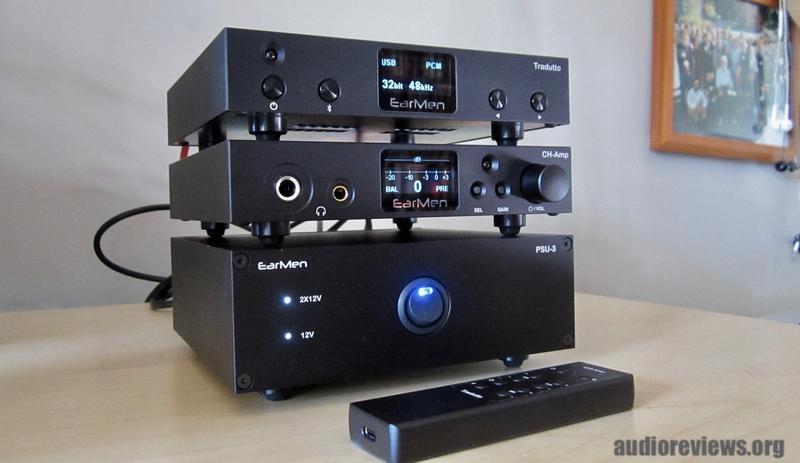
Features
The CH-Amp is a fully balanced amplifier that comes with a sophisticated linear power supply that handles an additional three devices. The CH-Amp features 2 circuits, a single-ended 6.35 mm one and a more powerful 4.4 mm balanced one. It deploys German quality WIMA capacitors, audio electrolytes in combination with MELF low noise resistors and SoundPlus OPA1642 operational amplifiers.
For balanced operation, the CH-Amp needs to be connected to a balanced DAC such as the EarMen Tradutto. EarMen are forward looking in their choice of 4.4 mm connectivity between DAC and amp for balanced sound…you also need a balanced cable for your headphone or earphone.
The CH-Amp features a safety mechanism to protect the attached equipment and our ears – as described below.
Operation
The CH-Amp features all its controlling features (buttons, knobs, display) in the front, and all its connectivity in the back.
Front Panel
The CH-Amp’s front panel is cleanly laid out and complements the overall shape. It features a 6.35 mm socket for the single-ended circuit, and a 4.4 mm socket for the balanced circuit.
The small OLED indicates the selected input (BAL, L1, L2) and the gain (high, low). If no headphone is connected, it indicates its pre-amp setting “PRE”. It also contains a nifty VU meter. The display is always on and cannot be dimmed, but it is subtle.
The tiny buttons to the right of the display let you select gain and line in. The on-off/volume knob can also be used as a mute button.
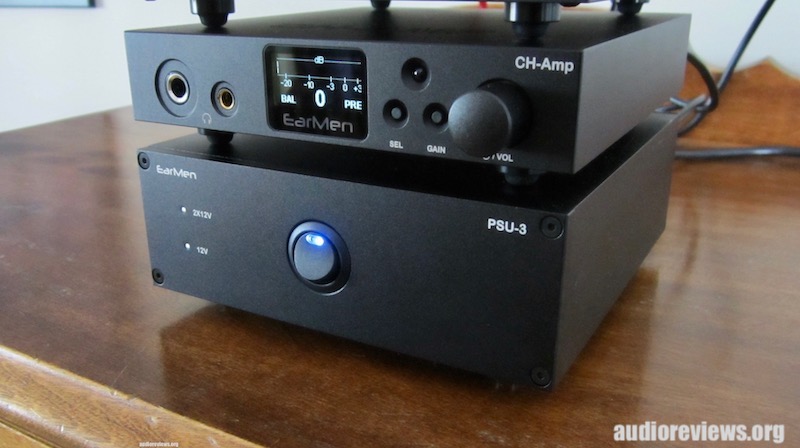
Back Panel
The CH-Amp’s back panel contains a 5-pin power input from the PSU-3 power supply, a 4.4 mm balanced socket, and 2 RCA inputs. This means you can connect 3 source devices simultaneously.
For use a pre-amp, the CH-Amp features a 4.4 mm balanced line out and RCA pre-outs. The 4.4 mm circuit is required to keep the stack’s dimensions down (XLR requires a much bigger chassis). The power supply’s back pane is discussed in detail below.
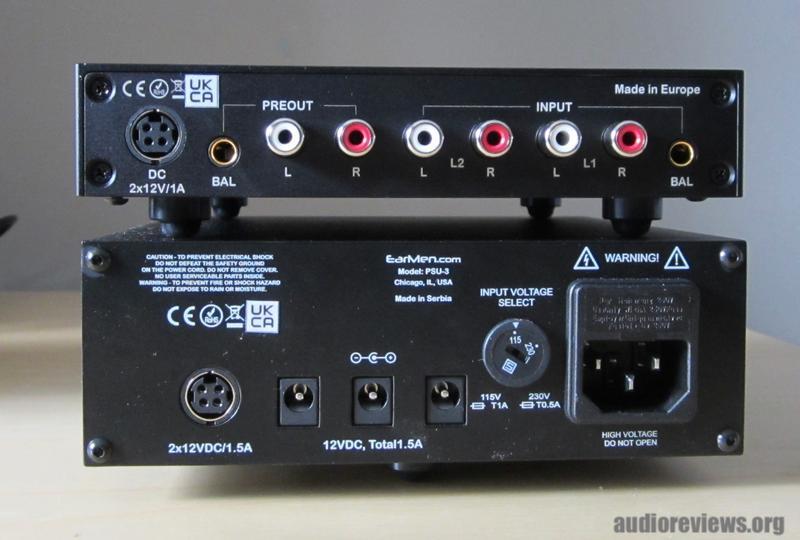
Switching the power supply on welcomes you with a loud “zong”…which is normal. You still have to switch the CH-Amp on individually (and the Tradutto) by pushing its volume knob.
By default, the CH-Amp is on volume level 0/low gain. After selecting the input and gain, you are ready to listen.
In the case you pull the headphone out of the socket, the volume automatically resets to 0. The knob physically moves back into this position under a clicking noise. It is a safety mechanism for protecting your equipment and your ears.
While this can be a cool effect, the gain also resets to low. I would prefer if the gain stayed on the previously chosen setting as it is not a safety requirement (zero volume is zero volume). It would be more convenient if gain selection was included in the remote’s functionality – which it is not.
The Remote
It is actually double remote for controlling the CH-Amp and the Tradutto DAC – and it also switches both devices on and off (but not the PSU-3). The remote is made entirely of metal with quality button mechanisms – and it contains a battery. It charges through any 5V power supply/computer outlet through its USB-C socket. Charger and cable are not included…less clutter.
The haptic is great, certainly much better than my drawer full of flimsy plastic remotes for operating my TV, some DACS, and even my premium Marantz SA8005 SACD player.
What one needs to get used to is the ergonomics (it is just a rectangular box with rounded corners) and the operational challenges. If you stack the Tradutto DAC on top of the CH-Amp/PSU-3, you may find it counterintuitive to have the CH-Amp’s buttons above the Tradutto’s buttons…and may as well sandwich the Tradutto between CH-Amp and PSU-3.
But, obviously, the CH-Amp has priority on the remote, as you may not own a Tradutto at all.
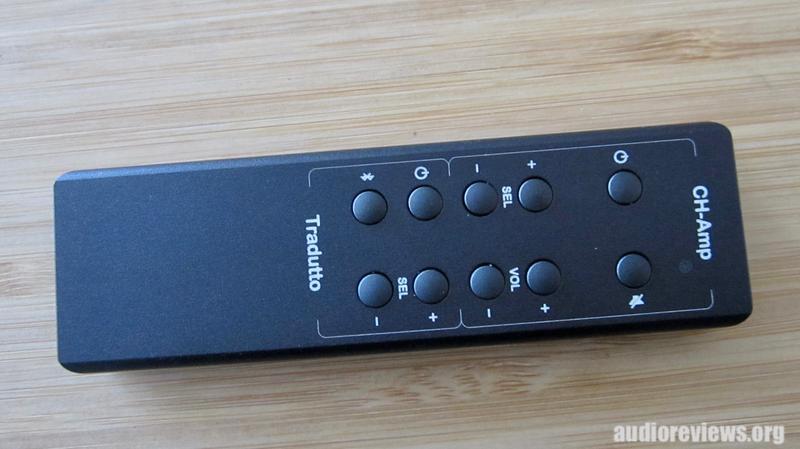
The other challenge is that the selection buttons of the CH-Amp (line ins: BAL, L1, L2) and the selection buttons of the Tradutto (inputs: USB, TOS, COAX, BT) are on opposing sides. All this in the context that the buttons are very close together. As mentioned, a gain control button is not included.
Again, this organization benefits the remote’s size, which is much smaller than any other remote for desktop devices I have – and which is in line with the small-size concept of the EarMen stack.
You may use the remote a lot if your arms are shorter than your headphone cable.
The PSU-3 Power Supply
It is evident that the device advertised as CH-Amp comes in two parts, the bigger and heavier of which is not an amplifier at all: the PSU-3 power supply. It features four power outlets (cables included) and therefore can supply three additional 12V devices other than the CH-Amp (such as the Tradutto DAC, EarMen’s Staccato Streamer, and another device of your choice).
The input voltage can be switched between 115 and 230 V. While it may look bulky, it actually saves a lot of space as discussed in the next chapter.
Power supplies are a very important and frequently underestimated part of our stereo systems. I have tested a few, and in my experience, they make a huge sonic difference – and I mean huge: not by adding sound quality but by minimizing its decay.
Examples are the Tradutto’s stock supply, the ifi Audio iPowerX and the Burson Super Charger, all of which are switching mode power supplies (like our phone/notebook chargers). They are smaller than the PSU-3 unit, which is a linear power supply (LPS).
A power supply is a transformer that connects the AC grid with the low voltage circuit of a device, let’s say a dac or an amp. The electricity coming out of your mains contains electromagnetic interference (RMI) and radio-frequency (RFI) interference, the amount of which depends on where you live. It will be worse in a city apartment building than in a house in the country.
There are two kinds of power supplies, switching more power supplies (SMPS) and linear power supplies (LPS). Both kinds principally work with your audio device.
The power supplies that come with your phone or notebook computer are SMPS. These are generally cheaper and (be it directly or indirectly) “noisier” than LPS in that they switch on and off very fast, which causes serious noise in the audio band – unless sophisticated filtering is used. Basic SPS will deteriorate the audio signal.
An LPS is typically less noisy as it provides constant signal and voltage power. However, bigger transformers are better than smaller ones (although they may measure the same), and they can be very expensive (and bulky). Such big LPS are probably only economic for very expensive gear.
That said, not all LPS are better than an SMPS. A “Maserati” SPS will be performing better than a “Fiat” LPS. And you can spend $$$$ on a good LPS.
An LPS is relatively bulky (up to microwave size) and heavy because it contains a big transformer, but it has a great price to performance ratio delivering a cleaner DC through a more stable voltage.
The smaller SMPS are generally noisier and deteriorate the signal more, unless you move into the super premium segment. But even a decent LPS can setup you back several hundred dollars. Easily!
EarMen’s engineers have obviously put a lot of thought into clean power.
If you also own the Tradutto, you can use its stock SMPS for other devices. The PSU-3 is a better power supply that upgrades the Tradutto’s sound, too.
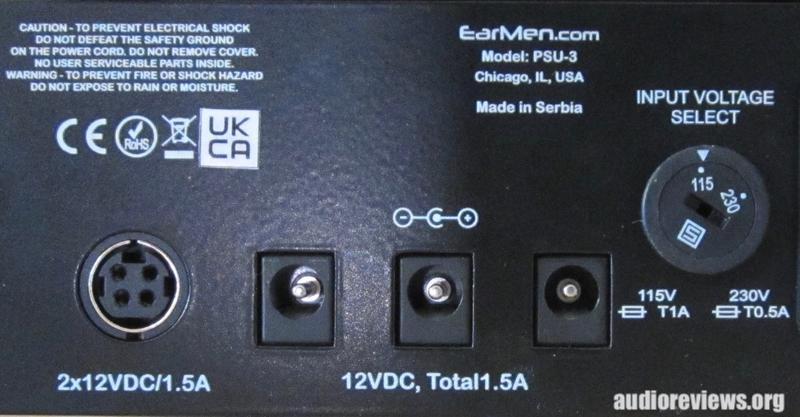
Amplification
The CH-Amp has a maximum power of 3.8 W for its balanced output on high gain @ 32 Ω. See the two tables below for details at other representative headphone impedances. EarMen does not recommend load impedance of 8 Ω (you can work around this by using the IE Match).
Balanced Output (4.4 mm)
| High Gain | Low Gain | |||
|---|---|---|---|---|
| Impedance (Ω) | Power (W) | Voltage (V) | Power (W) | Voltage (V) |
| 600 | 0.2 | 11 | 0.05 | 5.5 |
| 300 | 0.4 | 11 | 0.1 | 5.5 |
| 150 | 0.81 | 11 | 0.2 | 5.5 |
| 50 | 2.42 | 11 | 0.6 | 5.5 |
| 32 | 3.8 | 11 | 0.95 | 5.5 |
| 16 | 7.56 (max. 3.8) | 11 | 1.9 | 5.5 |
Single-ended Output (6.35 mm)
| High Gain | Low Gain | |||
|---|---|---|---|---|
| Impedance (Ω) | Power (W) | Voltage (V) | Power (W) | Voltage (V) |
| 600 | 0.082 | 7 | 0.014 | 2.9 |
| 300 | 0.163 | 7 | 0.028 | 2.9 |
| 150 | 0.33 | 7 | 0.056 | 2.9 |
| 50 | 1 | 7 | 0.17 | 2.9 |
| 32 | 1.53 | 7 | 0.26 | 2.9 |
| 16 | 3 (max. 1.5) | 6.9 | .52 | 2.9 |
I tested the CH-Amp with the EarMen Tradutto DAC, sourced my a MacBook Air. I mainly used two headphones, the power-hungry 300 Ω Sennheiser HD 600 and the easy-to-drive 16 Ω Final Sonorous III, both with 4.4 mm balanced cables. The CH-Amp’s volume scale ranges from 0 to 30.
With the Senns, I turned the volume to 15 (on high gain) for a “healthy” sound, and to about 20 for loud music. 25 was hurting my eardrums. The Sonorous played already really loud at 9 on the dial (on low gain). 6 was enough for normal listening.
Driving the 32 Ω Beyerdynamic Custom Pro and the 70 Ω Sennheiser HD25 on the single-ended circuit on low gain also was a piece of cake for the CH-Amp.
The CH-Amp will drive any headphone sufficiently (except, perhaps some rare, particularly “hungry” planars).
Sound
I tested with the EarMen Tradutto DAC sourced by a MacBook Air.
The CH-Amp’s sound is essentially uncoloured, maybe with a very slight lift at the low end (depending on source and interconnects). Transparency is excellent, staging and extension vary with transducer: the Sennheiser HD 600 play way more open than the Final Sonorous III.
There is obviously a sonic difference between the balanced and single-ended circuits (apart from power). The balanced circuit adds more depth to the sonic image – and produces an overall more “balanced” sound. It is the 4.4 mm circuit that makes the CH-Amp shine.
I have been listening over 2 months with headphones of impedances as low as 16 Ω and do not register any hiss. One recording I am getting back to again and again is Miles Davis’ classic 1959 Kind of Blue album (in the 2007 digital hybrid SACD SICP 10083 version from Sony Japan), in combination with the Sennheiser HD 600 (with balanced cable). In my experience, it feels like being in the studio: excellent transparency, crispness, resolution, and control. The sound is vivid yet natural and balanced. An addictive experience.
In comparison, the Tradutto with the similarly powerful Burson Funk (with the V6 Classic opamps and the Super Charger power supply) creates a warmer and flatter sound (as it lacks a balanced circuit).
The CH-Amp, in combination with the EarMen Tradutto produces the best sound I have experienced with my headphones. It is a truly complete (balanced) package!
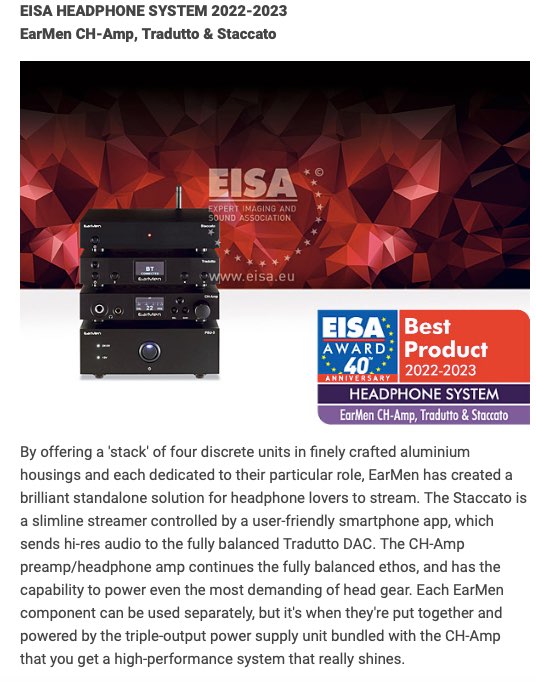
Does Size Matter?
On my desk, space is sparse – and size matters a lot. The Marie Kondo in me wants a setup with the best possible sound and yet the smallest possible footprint — and as little (cable) clutter as possible.
The EarMen stack (Tradutto, CH-Amp, and Staccato streamer) occupies the smallest possible area of any stack in its category. It is building up rather than out, just like skyscrapers in mega cities – and it occupies barely more area than a CD.
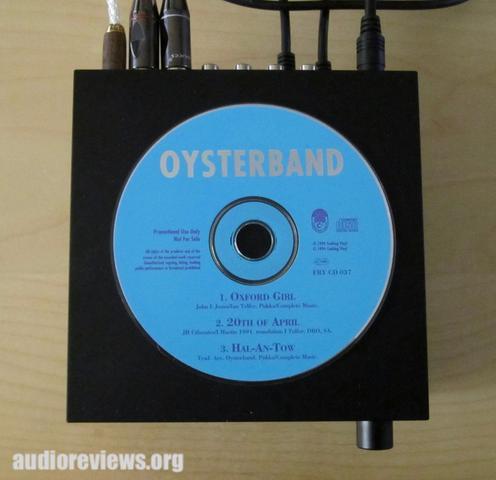
Its footprint is further minimized by the lack of cable clutter: the single, short 4.4 mm Pentaconn cables takes way less space than the two bulky XLR ones it replaces. I ordered my megumi copper cable from Hart Audio, who also consider the less cumbersome 4.4 mm cables as convenient.
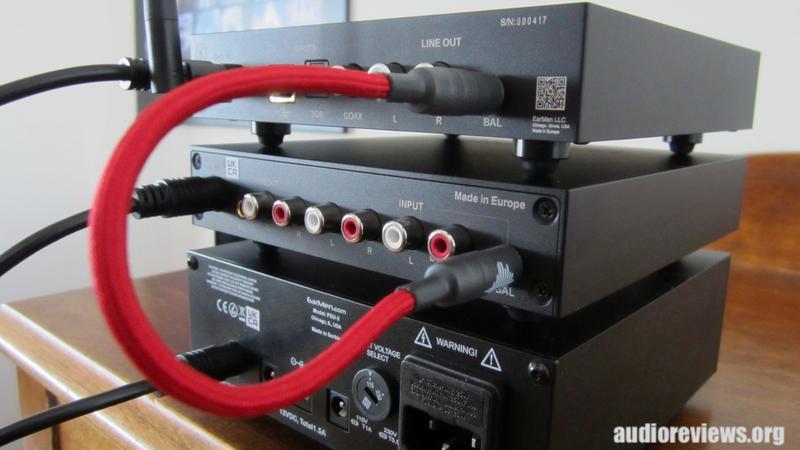
The third space saving takes place underneath our desks. Instead of needing four wall outlets or a power bar with three additional external power supplies dangling around our feet (which may introduce potential interference issues), the PSU-3 needs only a single power cord/power outlet for supplying the CH-Amp and another three 12 V devices.
If you, let’s say, only use the PSU-3 for the CH-Amp and Tradutto, you can connect any other two 12 V device to it. For example, it works for the TempoTec Serenade X player – and it improves its sound substantially compared to its stock supply (even the Tradutto’s stock power supply makes the Serenade X sound much better).
In summary, “less is more” and the EarMen stack’s size is very handy. With one less problem, I can leave the desk clutter intermittently to books and papers.
Concluding Remarks
In summary, the CH-Amp is characterized by a clean industrial design, clean power, clean sound, and clean cable organization with the smallest possible footprint.
Both CH-Amp and Tradutto make for a fantastic stack, a complete package that made it well worth re-equipping my favourite headphones with 4.4 mm balanced cables (check the “Gallery” below for details.
The EarMen stack is the best best desktop combo I have tested. Period. And it is more than enough for my sonic needs. It is not often that such a great device hits my test bench.
In the end, “We are the CH-Ampions” applies…please excuse the pun.
For best results, pair the CH-Amp with the Tradutto.
Until next time…keep on listening!

Disclaimer
Our generic standard disclaimer.


Gallery
